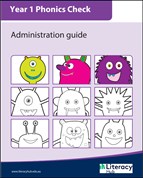Prepare for and administer the Year 1 Phonics Check
To administer the Year 1 Phonics Check you will need to:
- set up an online account for your school
- familiarise yourself with the Phonics Check
- know how to administer the Phonics Check.
1. Set up an online account for your school
The online Year 1 Phonics Check platform allows Australian schools to set up classes, assign checks to students, conduct the Phonics Check and report on student results. Schools can create a free online account to access and administer the Phonics Check. Teachers can access the Phonics Check by using their single sign-on or teacher email address.
Phonics Check user manual: Register and manage user accounts
This technical user manual provides instructions for school administrators* and teachers on how to register for the Year 1 Phonics Check platform and manage user accounts.
*Note: the first person to sign up at a school is automatically assigned as the school administrator. This can be updated by emailing our helpdesk.
2. Familiarise yourself with the Year 1 Phonics Check
Before administering the Year 1 Phonics Check, familiarise yourself with:
Everything you need to know can be found in the Year 1 Phonics Check: Administration guide. |
Key materials
The table below lists the materials you will need to administer the Year 1 Phonics Check and their purpose. It also details what materials you will need for the different delivery modes.
Before you administer the Phonics Check, ensure you have downloaded all the required materials from the links below.
|
Year 1 Phonics Check materials |
Purpose |
Delivery mode |
|
|
Online |
Offline |
||
|
Provides examples of real and pseudo words to familiarise students with the format of the Phonics Check. |
√ |
√ |
|
|
Provides advice on acceptable pronunciation of the real and pseudo words students will encounter in the Phonics Check. |
√ |
√ |
|
|
|
Provides a consistent script to use for delivering the Phonics Check to students. |
√ |
√ |
|
Provides the pseudo and real words for students to read aloud during administration of the Phonics Check. |
|
√ |
|
|
Provides a template to record students’ responses to each item on the Phonics Check, including comments to support student analysis. |
|
√ One copy per student |
|
New test items in 2024
Test items for the Year 1 Phonics Check have been updated in January 2024.
| Pseudo words | Real words | |
|
Section 1: simple code |
|
|
|
Section 2: complex code |
|
|
Further resources
The following resources provide further information related to the Year 1 Phonics Check.
This document explains what the Simple View of Reading is and provides a framework for teachers to understand specific skills students need to become successful readers.
In the final module in this video series about systematic synthetic phonics (SSP), Jocelyn Seamer, an expert in systematic reading instruction, discusses the features of an SSP approach.
This document outlines how the words assessed in the Year 1 Phonics Check align with the Australian Curriculum V9 and the National Literacy Learning Progression.
3. Know how to administer the Year 1 Phonics Check
Once you are familiar with the Year 1 Phonics Check and you have set up your account, you can get started.
Phonics Check user manual: Phonics Check delivery
This technical user manual provides instructions for school administrators and teachers when using the online platform on how to set up classes and add students, conduct the Phonics Check, and view reports.
Year 1 Phonics Check: Administration guide
This guide provides detailed information for school leaders and teachers on preparing for the Phonics Check, administering the Phonics Check, recording student responses and scoring guidance.
Administration in action
These four videos show a teacher administering the Year 1 Phonics Check with students of differing abilities. Each video also shows the teacher and a colleague discussing next steps for the student.
Student 1: Efficient decoding skills
Student 2: Given wait time to decode words
Student 3: Efficient recall and application of simple and complex code
Student 4: Knowledge and application of simple code
Information for families
Schools are encouraged to communicate with their families about the Year 1 Phonics Check. The What is the Year 1 Phonics Check? webpage explains to families the purpose of the Phonics Check, how it’s administered and what happens afterwards.
